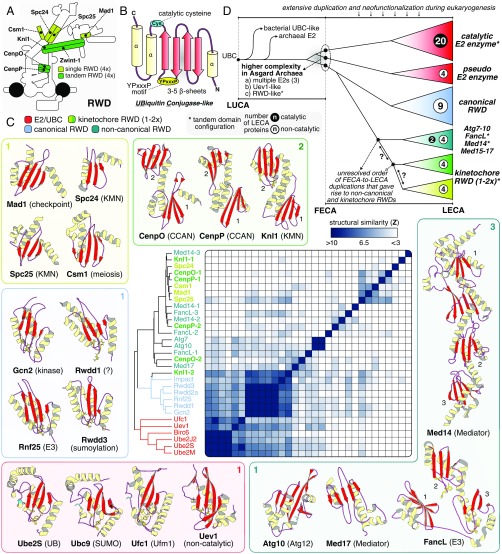Fig. 2.
Kinetochore RWDs are an expanded class of noncatalytic E2 UBCs. (A) Overview of the position of eight kinetochore proteins with a single (light green) or a tandem (dark green) RWD configuration. (B) RWD domains are part of the UBC superfamily. The secondary structure of the UBC superfamily is characterized by a “β-meander” of three to five β-sheets enclosed by ɑ-helices at both termini, a YPxxxP motif, and a catalytic cysteine residue (lost in RWDs). (C) The UBC superfamily can be subdivided into four classes: (i) E2 UBCs (E2), including noncatalytic pseudo E2s (e.g., Uev1); (ii) canonical RWDs; (iii) kinetochore RWDs; and (iv) atypical RWD/UBC-like (e.g., FancL, Med14-17). Per class, the structure of various members is depicted to show the overall structural and topological similarity, and a known molecular function is indicated between brackets. When present, YPxxxP (yellow) and the catalytic cysteine (cyan) are represented in a sticks configuration. The average linkage clustering of structural similarity scores of single UBC domains (z-scores) demonstrates the close similarity amongst E2s and canonical RWD domains. Kinetochore RWDs and noncanonical domains are more divergent and cluster together. (D) Cartoon of the evolutionary reconstruction of the UBC superfamily based on phylogenetic analyses (SI Appendix, Figs. S1E and S3) and structural comparisons (Dataset S2). Extensive duplication and neofunctionalization of an archaeal E2 UBC gave rise to a large complexity of catalytic and noncatalytic E2/RWD proteins in LECA (see numbers per class). Possibly a part of this eukaryotic complexity was already present in FECA, since Asgard Archaea contain multiple E2 conjugases, an Uev-like homolog, and an RWD-like domain (SI Appendix, Fig. S3). Kinetochore RWDs might have a monophyletic origin, although a structural affiliation with other divergent proteins signify a more complex evolutionary scenario (see question marks).

